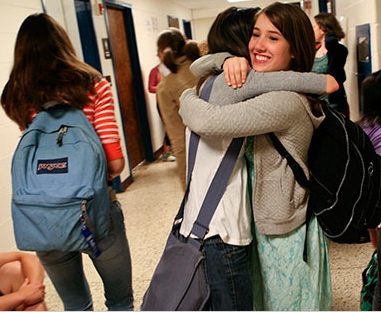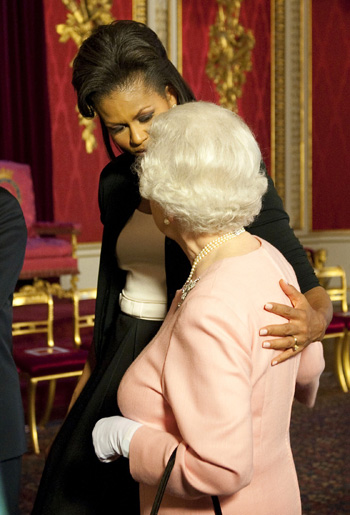
Fred R. Conrad/The New York Times
Warmth, affection, connection, community: physical social networks and emerging branding trends.
It’s been suggested that the phenomenon of teenagers hugging has something to do with Michelle Obama. She hugs everyone. She’s even been decried for her supposed slip in royal protocol by hugging the Queen of England, Royal Mother that she is.
According to the Huffington Post, as well as a rendering from the Queen’s “ritual analysis”, PR team, “a Buckingham Palace spokesman who asked not to be identified because of palace policy said he could not remember the last time the queen had displayed such public affection with a first lady or dignitary. “It was a mutual and spontaneous display of affection,” he said. “We don’t issue instructions on not touching the queen.”

Lots of protocol fluff is being made of Michelle Obama and Queen Elizabeth’s embrace. As the First Lady and Queen chatted at the G-20 reception, the Queen touched her hand to Michelle Obama’s back, and the gesture was then returned in response. According to the royal etiquette dictates, the Queen not be touched unless she reaches out first. Patting the Queen’s back, however, is almost unprecedented behavior in Buckingham Palace.
Curiously enough, it was reciprocal.
Touch, hug, connect. Reflection.
It does speak to warmth. And humanity. And in a way, to the emerging and continuous fray of our times, I believe that people are doing more hugging in a variety of ways, because they need it.
And business needs it as well. All of us, working people, might find that personal attentiveness to brand relationships — extant or new client partners — is about the degree of commitment to the relationship. In these challenging times, the more that you are connected to your client, the more powerful the relationship. That works for retail as well, according to friend, retail designer and architect Dawn A. Clark, she points out that the trend to relationships, localization, on site reciprocity in response to “the floor”, is crucial for survival. A reference, yesterday, confirms the proposition. Now, people seeking retail exchanges are likely to pursue purchases in the context of personal connections.
Personally, writing about social networks, the human brand and personality, the components of connectedness and community, I’d ally myself with the positioning that this relates to a kind of “new warmth”. You can’t deny the premise that the shift from MySpace to Facebook doesn’t bode some kind of symbolic link to psychic connectedness. Why else? MySpace pages have a certain kind of structural remoteness, while Facebook operates in an endlessly iterative if not viral way. Friends become friends, who find other friends, and the genetic code of linking in becomes clearer.
Besides that, it’s simpler. And in the present world, simpler is better.
Trends show transitions. Facebook bypassed MySpace in terms of total U.S. visitors for the first time in May, 2009, as Facebook’s popularity in terms its user base continued to soar. Facebook attracted in 70.278 million unique visitors in the states, compared to MySpace’s 70.237 million, according to data released by ComScore. Facebook became the most popular site in the U.S., in terms of visitors. One month earlier, Facebook had a little over 67 million U.S. visitors behind MySpace’s 70.9 million. A year ago, in May 2008, Facebook was at 36 million unique visitors compared to 73.7 million for MySpace.
But why? It’s more huggable? According to Danah Boyd, it’s class-based, meaning that it’s a socio-economic positioning to be “cool” in either the one, or the other. Interestingly enough, she points out that the difference, to trend, has to do with the communal vibe of MySpace, and the look of it, as merely to the features and offerings:
“They see it as gaudy, immature, and “so middle school.” They prefer the “clean” look of Facebook, noting that it is more mature and that MySpace is “so lame.” What hegemonic teens call gaudy can also be labeled as “glitzy” or “bling” or “fly” (or what my generation would call “phat”) by subaltern teens. Terms like “bling” come out of hip-hop culture where showy, sparkly, brash visual displays are acceptable and valued. The look and feel of MySpace resonates far better with subaltern communities than it does with the upwardly mobile hegemonic teens. This is even clear in the blogosphere where people talk about how gauche MySpace is while commending Facebook on its aesthetics.”
What one might suppose, to the rolling trend of teenage brand wisdom, is that it’s just that, a trend. But what, psychically, does the trend suggest?
Warmth. Clarity. Clean.
While the look and feel of Facebook might be cleaner, it’s more open to the constructs of sharing, and in that, embracing others and sharing friendship and connection. And, as well, there’s another layering of implied intelligence, connected with it, according to Boyd’s interviews.
“That “clean” or “modern” look of Facebook is akin to West Elm or Pottery Barn or any poshy Scandinavian design house (that I admit I’m drawn to) while the more flashy look of MySpace resembles the Las Vegas imagery that attracts millions every year. I suspect that lifestyles have aesthetic values and that these are being reproduced on MySpace and Facebook.”
Okay, so I’m veering.
But the real point, to all of this for me is about I trend I’m seeing in clients. Brands that are looking for better ways to express a human connection.
The opening percolation of this trend for me, as a movement that I’m studying, business brands, personal brands, started with the hug, which in a way, I see metaphorically. That if there’s a trend in hugging, what does that mean? And what does it symbolize in brand space?
The crossover: hugging is a physical gesture, it has migrated online as well. “Facebook applications allowing friends to send hugs have tens of thousands of fans. Katie Dea, the San Francisco eighth grader, as well as Olivia Brown, 11, who lives in Manhattan and is the younger sister of Gabrielle, the LaGuardia High freshman, have a new sign-off for their text and e-mail messages: *hug.*” This in reference to a NYTimes article, authored by Sarah Kershaw.
It goes on. “It’s a wordless custom, from what I’ve observed,” wrote Beth J. Harpaz, the mother of two boys, 11 and 16, and a parenting columnist for The Associated Press, in a new book, “13 Is the New 18.”
“And there doesn’t seem to be any other overt way in which they acknowledge knowing each other,” she continued, describing the scene at her older son’s school in Manhattan. “No hi, no smile, no wave, no high-five — just the hug. Witnessing this interaction always makes me feel like I am a tourist in a country where I do not know the customs and cannot speak the language.”
For teenagers, though, hugging is hip.” And teenagers are not only about understanding the trend, but being on the trend — first. While the opening proposition of the brand, post-Harvard, was teenagers — now the population is burgeoning with Facebook(ers) of all ages.
As an emerging phenomenon, it might be reflective of evolution. Amy L. Best, a sociologist at George Mason University, said the teenage embrace is more a reflection of the overall evolution of the American greeting, which has become less formal since the 1970s. “Without question, the boundaries of touch have changed in American culture,” she said. “We display bodies more readily, there are fewer rules governing body touch and a lot more permissible access to other people’s bodies.”
“Maybe it’s because all these kids do is text and go on Facebook so they don’t even have human contact anymore,”
said Dona Eichner, the mother of freshman and junior girls in high school.
The gesture, for me, is about a trend to warmth. Person to person, person to brand, brand to person. Presidential spouse to the Queen of England. One story makes another. And if it’s a good one, people listen. And they hug it.
That’s what we want.
tsg
….
Brandstory: Love | brand | person
blogs:
https://www.girvin.com/blog
https://tim.girvin.com/index.php
Twitter: http://twitter.com/tgirvin